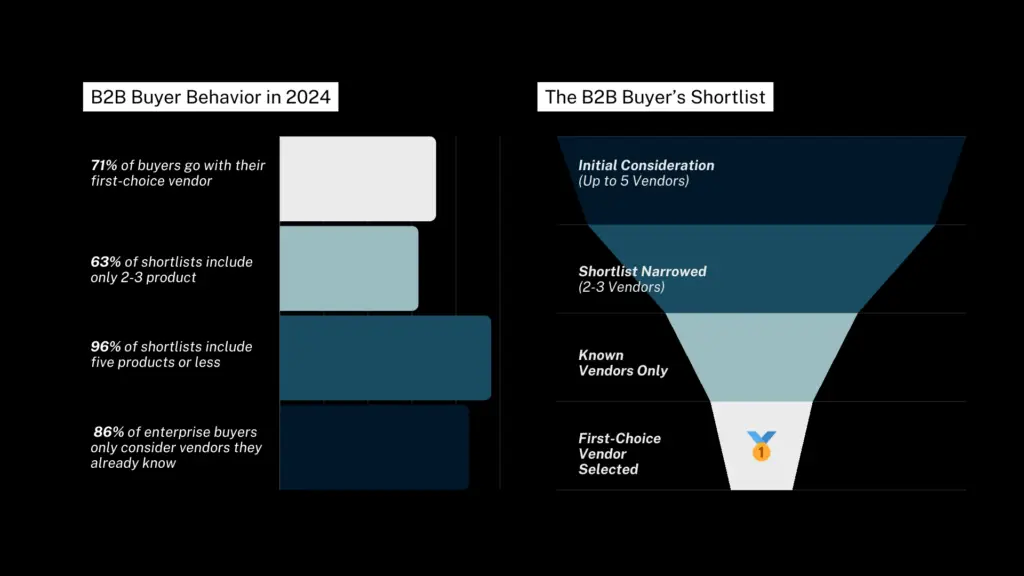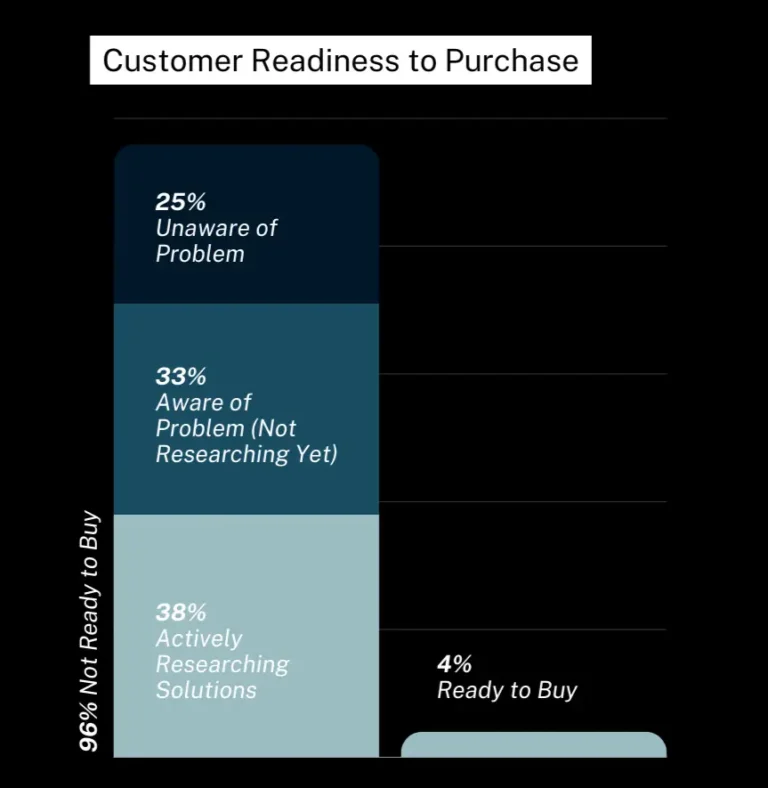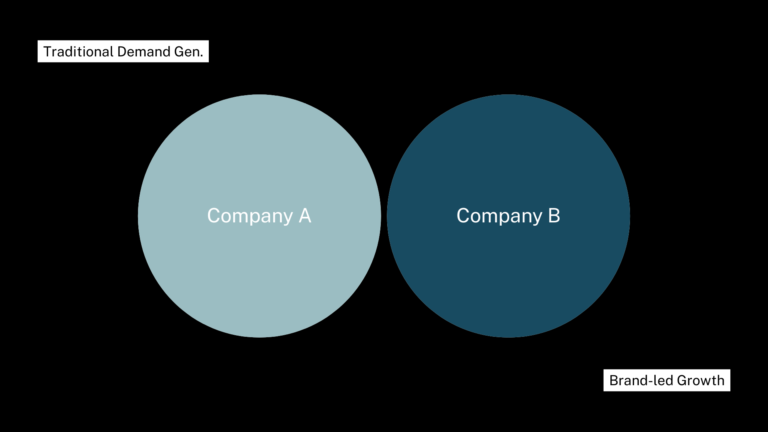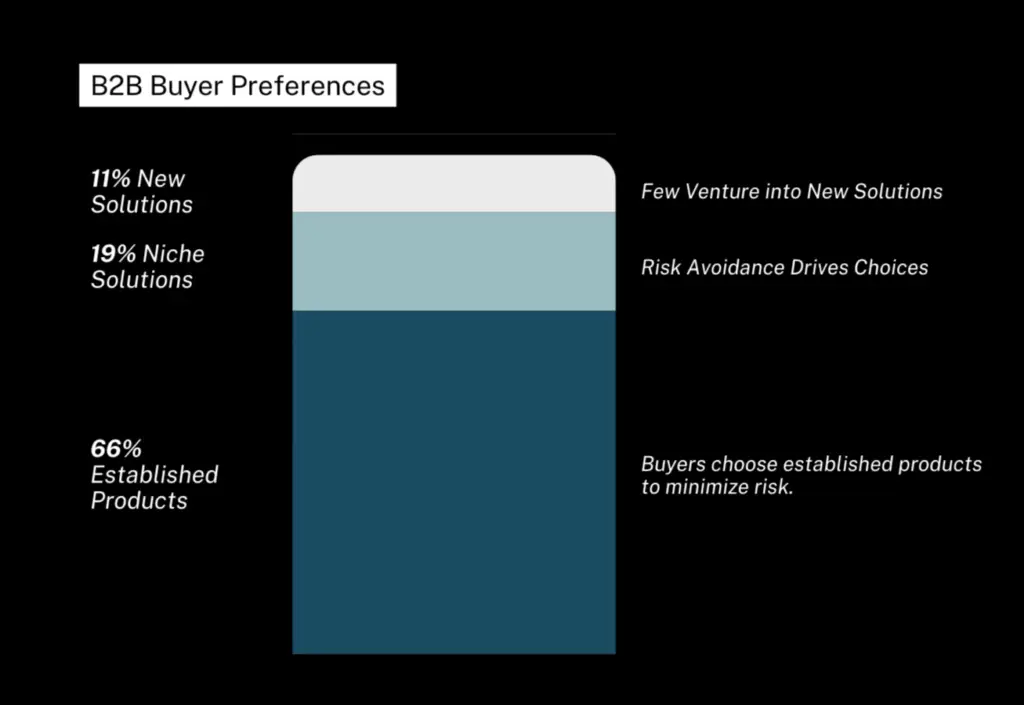Let me explain.
According to the latest research by HubSpot and Adobe, a staggering 96% of your potential customers aren’t ready to buy… yet. Read that again. The vast majority of your future customers are out there, forming opinions, making mental shortlists, and deciding who they’ll trust – long before they ever enter your sales pipeline.
But here’s where it gets interesting (or terrifying, depending on your current strategy).

Think about that for a moment. While your sales team is grinding through cold calls and your marketing team is optimizing those bottom-of-funnel campaigns, your future customers are already deciding whether you’ll be in the running… when they’re ready to buy.
“But we need results now!” I hear you say. I get it. The pressure to deliver immediate pipeline growth is real. But here’s the reality check: by focusing only on that 4% of ready-to-buy prospects, you’re setting yourself up for increasingly expensive customer acquisition and diminishing returns.
- Why the traditional demand generation playbook is becoming less effective by the day
- How the most successful B2B companies are capturing the entire market, not just active buyers.
- A practical framework for building tomorrow’s pipeline today
- Real strategies that don’t force you to choose between short-term results and long-term growth
Ready to stop fighting for scraps and start capturing the whole market? Let’s dive in.
Before we continue: This article is based on extensive research from HubSpot, Adobe, TrustRadius, and our own experience working with fast-growing B2B companies. Every claim is backed by data, and every strategy has been tested in the real world.
The B2B Buying Reality in 2024
If you think B2B buying hasn’t changed much in recent years, you’re in for a wake-up call. The game has fundamentally shifted, and many companies are still playing by last decade’s rules.
The New B2B Buying Behavior

- 71% of buyers go with their first-choice vendor
- 63% of shortlists include only 2-3 products
- 96% of shortlists include five products or less
- 86% of enterprise buyers only consider vendors they already know
The Shortlist Phenomenon: Why Your Brand is Everything
Your prospect opens their laptop one morning, finally ready to solve that pressing business problem. Before they type their first Google search, they already have a mental shortlist of potential solutions. If you’re not on that list, you’re probably not getting the deal – no matter how good your product is or how skilled your sales team might be.
“But we rank well on Google!” you might say. That’s great, but according to the same research, by the time prospects start their formal research process, they’re mainly looking to validate their existing preferences and justify their choices to other stakeholders.
Think about that for a second: The actual decision is often made before the official “buying process” even begins.
Why Traditional Demand Generation is Failing
1. The Cold Outreach Crisis
- Cold calls and emails are getting ignored because buyers already know who they want to talk to
- Your “personalized” outreach is competing against pre-existing brand preferences
- The cost per qualified lead keeps rising while conversion rates drop
2. The Content Paradox
- You’re producing more content than ever
- Your competitors are producing more content than ever
- But buyers are engaging with less vendor content than before
- Why? Because they’re choosing who to listen to based on pre-existing brand trust
3. The Pipeline Problem
- Sales cycles are getting longer (up 20% in the last two years)
- More decision-makers are involved (typically 6-10 people)
- Yet companies are spending more on bottom-of-funnel tactics that target only active buyers
And let’s be real: Hope is not a strategy.
The New Math of B2B Growth
Consider these numbers:
- Traditional demand gen: Fighting for 4% of the market with everyone else
- Brand-led growth: Building preference with 100% of your market
- Result: When the 96% eventually enter buying mode, they already know and trust you
In the next section, we’ll dive deep into that 96% opportunity – who these future buyers are, what they’re doing right now, and most importantly, how to capture their attention and trust before they ever enter an active buying cycle.
Up next: Understanding and capturing the 96% opportunity – why these “not ready” buyers are actually your biggest asset.
The 96% Opportunity: Understanding the Full Market
Breaking Down the 96%
- 38% are actively researching solutions (but not “buying”)
- 33% are aware they have a problem (but not researching yet)
- 25% don’t even know they have a problem (but will)

The Five Mindsets of Future Buyers
1. The Status Quo Settlers
- “Things are fine for now”
- But: They’re one competitor announcement away from realizing they’re falling behind
- Your opportunity: Show them what’s possible before they feel the pain
2. The Silent Researchers
- Quietly exploring options
- Not ready to talk to sales
- But consuming content like it’s Netflix
- Your opportunity: Be their trusted guide and educator
3. The Problem Aware
- Know they have a challenge
- Haven’t prioritized solving it yet
- Your opportunity: Help them build the business case internally
4. The Budget Waiters
- Want to solve the problem
- No budget… yet
- But planning for next quarter/year
- Your opportunity: Stay top of mind until the money appears
5. The Future Needs
- Not in your market today
- But will be as they grow/evolve
- Your opportunity: Plant the seeds for future harvest
Why These "Not Ready" Buyers Are Your Biggest Asset
1. They're Not Under Pressure
- Can absorb your message without the stress of an active buying process
- More likely to remember and share your content
- Building genuine preference, not just checking boxes
2. They're Cheaper to Reach
- Not being bombarded by your competitors
- Lower cost-per-engagement
- More organic sharing potential
3. They're Building Real Trust
- Forming opinions based on value, not sales pressure
- More likely to become advocates later
- Higher lifetime value potential
4. They're Your Future Pipeline
- When they do enter buying mode, they’re essentially pre-sold
- Shorter sales cycles
- Higher win rates
The Compound Effect
While your competitors are spending more and more to fight over the same small pool of active buyers, you’re building compound interest with the other 96%.
The result?
- Lower customer acquisition costs
- More inbound opportunities
- Shorter sales cycles
- Higher win rates
- Better customer retention
The Real Question
The real question is: Can you afford not to?
Up next: The hidden costs of ignoring brand building – and why it’s more expensive than you think.
The Hidden Cost of Ignoring Brand Building
The 4% Bloodbath
Here’s what your competition is doing right now:
- Increasing their paid search budgets to bid on the same keywords
- Spamming the same decision-makers on LinkedIn
- Running remarketing campaigns to the same pool of prospects
- Fighting over the same speaking slots at industry events
- Targeting the same “intent data” signals
The result? A brutal race to the bottom where:
- Cost per click has increased by 30-40% year over year
- LinkedIn InMail response rates have plummeted
- Sales outreach effectiveness is at an all-time low
- Customer acquisition costs are skyrocketing
The Price of Being Late to the Party
Picture this all-too-common scenario:
- Your sales team finally gets a meeting with a dream prospect
- The conversation goes great
- Your solution is perfect for their needs
- Your pricing is competitive
- But… they already have a “preferred vendor” in mind
You’re now in the dreaded “column B” position – being used to validate the prospect’s existing preference or negotiate with their preferred vendor. Your chances of winning? According to TrustRadius, about 12%.
Even worse? You’re spending 2-3x more to acquire these opportunities than your better-known competitors, only to lose most of them anyway.
The Real Competition Isn't Who You Think
Your real competition is irrelevance.
While you’re focused on that 4%:
- Hundreds of potential buyers are forming opinions without you
- Future decision-makers are building their vendor knowledge base
- Industry conversations are happening without your voice
- Trusted relationships are being built by others
The Compound Advantage
Meanwhile, the smart players are playing a different game entirely:
- Building authority through consistent thought leadership
- Engaging with the entire market, not just active buyers
- Creating content that serves their audience’s current needs, not just their product pitch
- Building communities and fostering genuine relationships
The result?
- They’re the first name that comes to mind when a need arises
- They get invited to pitch instead of begging for meetings
- Their cost per opportunity is dropping while yours rises
- They’re winning deals before the competition even knows there’s an opportunity
A Tale of Two Approaches

Company A (Traditional Demand Gen)
- Spends 80% of budget on bottom-funnel activities
- Fights for every lead
- Increasing CPL/CAC every quarter
- Lengthy sales cycles
- Win rate: 15-20%
Company B (Brand-led Growth)
- Invests in market-wide visibility
- Creates genuine thought leadership
- Builds relationships before they’re needed
- Gets invited to pitch
- Win rate: 45-60%
The Wake-Up Call
The truth is, while you’re busy optimizing your bottom-of-funnel campaigns and fighting for that 4%, your smarter competitors are:
- Building preference with tomorrow’s buyers
- Decreasing their customer acquisition costs
- Shortening their sales cycles
- Increasing their win rates
Up next: Why buyers choose known brands – the psychology behind B2B brand preference.
Why Buyers Choose Known Brands
Here’s a hint: It’s not features, and it’s not even price.
The Risk Factor
According to TrustRadius’s research, the primary driver in B2B decisions is risk mitigation. Think about it:
- Wrong choice? Could cost them their job
- Failed implementation? Their reputation takes a hit
- Budget waste? That’s coming up in their next review

The Psychology of B2B Brand Preference
1. Familiarity = Safety
- Known brands feel less risky
- Recognition builds implicit trust
- Easier to justify to stakeholders
2. The "Nobody Got Fired" Effect
- Well-known brands are seen as the safe choice
- Provides built-in justification for the decision
- Reduces perceived personal risk
3. Mental Availability
- First brands that come to mind get first consideration
- Familiar brands require less cognitive effort to evaluate
- Pre-existing knowledge reduces decision fatigue
The Full Journey Impact
Brand awareness doesn’t just influence the final decision – it shapes the entire buying journey:
Pre-Research Phase
- Creates mental shortlists
- Builds implicit trust
- Establishes price expectations
Research Phase
- Guides initial searches
- Filters potential options
- Influences content consumption
Evaluation Phase
- Affects how features are perceived
- Impacts price sensitivity
- Influences stakeholder discussions
Decision Phase
- Reduces perceived risk
- Accelerates consensus building
- Justifies the final choic
Building Tomorrow's Pipeline Today
The 96% Strategy Framework
Brand awareness doesn’t just influence the final decision – it shapes the entire buying journey:
1. Market-Wide Presence
- Be everywhere your future buyers are
- Consistent messaging across channels
- Focus on value, not promotion
2. Content That Serves
- Help solve today’s problems
- Build authority through genuine insight
- Create resources that last
3. Community Building
- Foster peer-to-peer discussions
- Create valuable networking opportunities
- Become the connection point for your industry
Content That Actually Works
1. Thought Leadership That Matters
- Industry analysis that goes deeper
- Original research and insights
- Contrarian views backed by data
2. Educational Content
- Practical tools and frameworks
- Real-world case studies
- Implementation guides
3. Community Content
- User-generated insights
- Peer discussions
- Industry trends and analysis
Balancing Short and Long Term
Short-term (20% of effort)
- Active buyer targeting
- Bottom-funnel optimization
- Sales enablement
Long-term (80% of effort)
- Brand awareness building
- Community development
- Thought leadership
- Relationship nurturing
Measuring Brand Building Success
Leading Indicators
1. Awareness Metrics
- Share of voice in your category
- Brand mention volume
- Social media engagement
- Content reach and sharing
2. Engagement Metrics
- Time spent with content
- Return visits
- Newsletter subscriptions
- Event participation
3. Community Metrics
- Community size and growth
- Discussion volume
- Member engagement
- Peer-to-peer interactions
Lagging Indicators
1. Business Impact
- Inbound inquiry quality
- Sales cycle length
- Win rates vs. competitors
- Customer acquisition costs
2. Market Position
- Category consideration rates
- Competitor comparison frequency
- Industry analyst recognition
- Partnership opportunities
Timeline Expectations
3-6 Months
- Increased social engagement
- Growing content consumption
- Early community formation
6-12 Months
- Rising inbound inquiry quality
- Improved sales conversations
- Growing word-of-mouth
12-24 Months
- Significant market position
- Reduced customer acquisition costs
- Strong brand preference
- Compound growth effects
ROI Calculation
Direct Impact
- Reduced acquisition costs
- Higher win rates
- Larger deal sizes
- Better retention rate
Indirect Impact
- Easier recruitment
- Better partnerships
- Premium pricing power
- Market protection
The key is to understand that brand building isn’t a campaign – it’s an asset that appreciates over time. The sooner you start building it, the more valuable it becomes.
Up next: Your practical implementation framework for capturing the 96%.
Implementation Framework
Phase 1: Foundation Building (Months 1-3)
1. Audit Your Current Position
- Brand mention baseline
- Share of voice analysis
- Competitor positioning review
- Current market perception
2. Define Your Space
- Core narrative development
- Key message architecture
- Thought leadership angles
- Content pillars
3. Build Your Platform
- Content distribution channels
- Community foundations
- Measurement framework
- Team alignment
Phase 2: Market Activation (Months 3-6)
1. Content Engine
- Thought leadership calendar
- Expert content creation
- Distribution automation
- Engagement workflows
2. Channel Strategy
- LinkedIn presence optimization
- Industry publication partnerships
- Community platform launch
- Event strategy
3. Team Enablement
- Executive social presence
- Employee advocacy program
- Sales and marketing alignment
- Content creation processes
Common Pitfalls to Avoid
1. The Patience Trap
- Expecting overnight results
- Abandoning too early
- Inconsistent execution
2. The Content Trap
- Creating more, not better
- Playing it too safe
- Following, not leading
3. The Focus Trap
- Trying to be everywhere
- Speaking to everyone
- Diluting your message
Quick Wins vs. Long-Term Investment
Quick Wins (First 90 Days)
- Executive LinkedIn presence
- Weekly thought leadership
- Industry event participation
- Community building initiation
Long-Term Investments
- Original research programs
- Content library development
- Community infrastructure
- Brand measurement systems
Conclusion: The 96% Decision
The question isn’t whether to invest in brand building – it’s whether you’ll do it before or after your competitors.
The Cost of Waiting
Every day you delay:
- Future buyers are forming preferences without you
- Competitors are building relationships with your prospects
- The cost of entry in your category increases
- Your future customer acquisition costs rise
The Opportunity
This is your chance to do it differently. To play a bigger game. To capture the 96%.
Next Steps
- Review your current marketing split between demand gen and brand building
- Audit your market position and share of voice
- Assess your thought leadership capabilities
- Map out your 12-month brand building strategy
Remember: The best time to start building your brand was years ago. The second best time is now.
Additional Resources
Research and Reports
- TrustRadius 2024 B2B Buying Disconnect Report
- HubSpot and Adobe B2B Buying Behavior Study
Tools and Templates
- Brand Building ROI Calculator
- Content Strategy Framework
- Share of Voice Tracking Template
- Brand Measurement Dashboard
Book your call with Ray Mollel now—no strings attached, just real value.
Subscribe to Demand Newsletter
If you’re not quite ready for the call, but you still want to stay ahead of the curve, sign up for our Demand Newsletter. It’s packed with insights that help startup leaders like you stay on top of your brand and revenue growth game.
We share actionable tips, real-world case studies, and fresh perspectives to keep your demand generation engine running smoothly. Don’t miss out.

